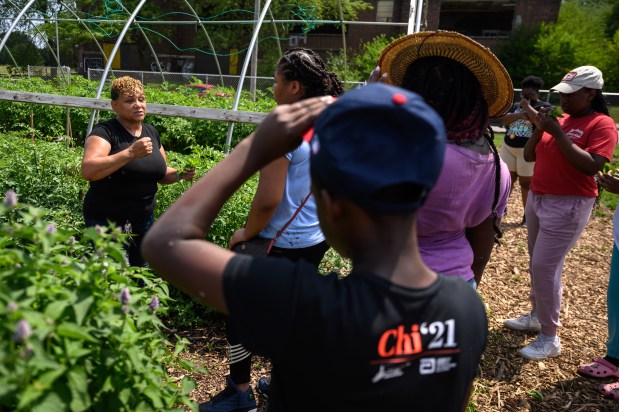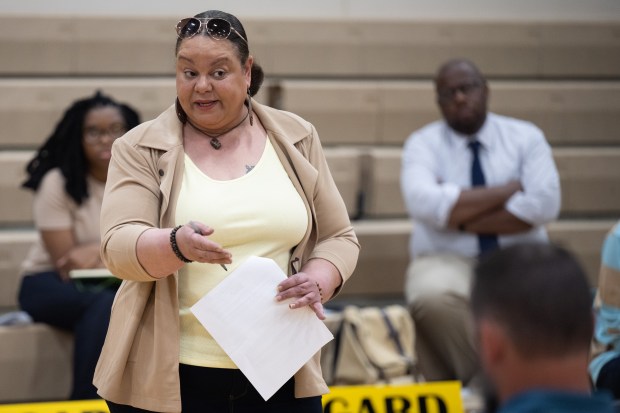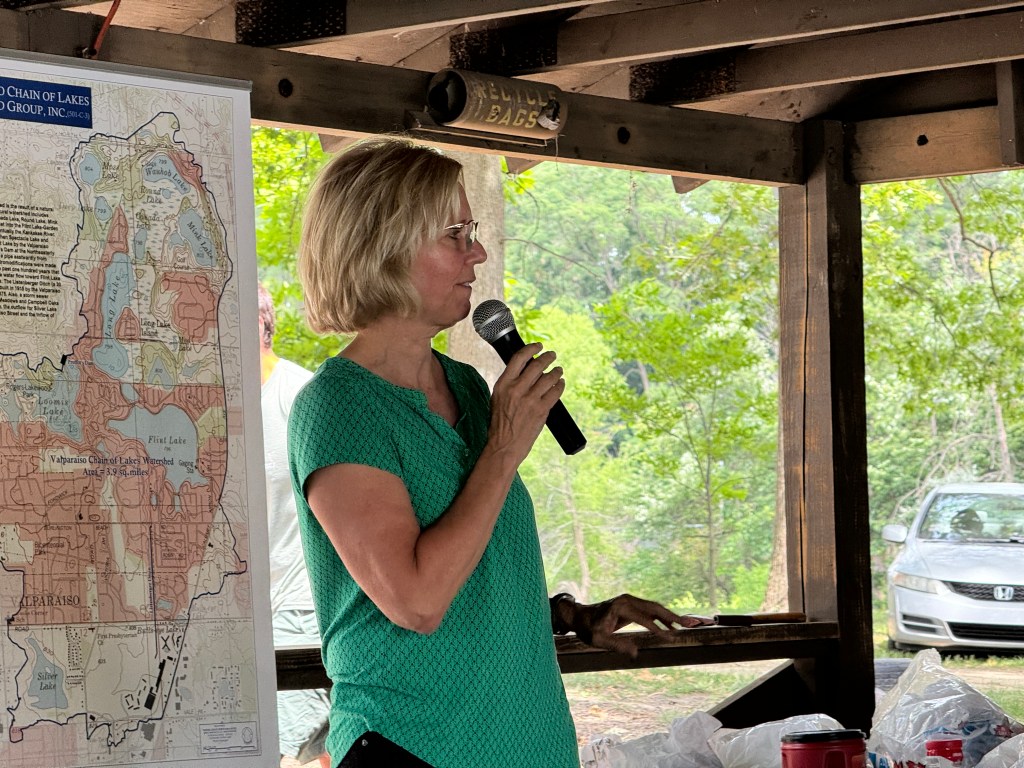The Northern Lake County Environmental Partnership puts local college students out in the field to gather data about pollution and health and connects them with community members, and residents are grateful for the positive environmental impact.
Freida Graves, a Gary resident and director of Food is Medicine for Faith CDC, said she’s excited for how their work will better the region’s future.
ct-ptb-gary-mural-st-0705

Andrew Burke-Stevenson/Chicago Tribune
Director of “Food is Medicine” Frieda Graves teaches kids and teens about what Faith Farms grow in Gary, Indiana on Wednesday, July 5, 2023. (Andrew Burke-Stevenson/for the Post-Tribune)
“I think we’re just getting started,” Graves said. “It’s a good thing we’re learning, but I think we have a long way to go. We’re willing to do the work and whatever it takes to get our environment up to par with other areas.”
Graves is a member of the community advisory board for the partnership, which connects residents with researchers and students from various schools, including the University of Notre Dame, Purdue University and Valparaiso University.
According to the partnership project’s website, the group is studying pollutants in the air, gas or fumes, metals and others. The group looks at how those pollutants might compare with rates of general health, cognition and mental health, according to the website.
Graham Peaslee, professor emeritus at the University of Notre Dame, said the project’s work includes East Chicago, Gary, Hammond and Whiting.
 

Kyle Telechan/Post-Tribune
Gary Advocates for Responsible Development co-founder Kimmie Gordon speaks to IDEM employees during a public meeting to discuss the renewal of Carmeuse Lime’s operating permit in Gary on Thursday, June 1, 2023. (Kyle Telechan for the Post-Tribune)
Peaslee said the project started after the group saw “areas of concerns” with pollutants in Lake County. The study works to sufficiently inform residents about the pollution levels and how it might impact the community.
“The residents are letting us study this material, but they’re going to get a report or multiple reports that show the dangers that are associated with being in this area,” Peaslee said. “Now that we know where it is, we can go a lot further towards predicting where the sources are.”
Peaslee didn’t say when the reports would be published, but he said they’ve submitted the first study with background for publication.
It’s essential to work with other universities, Peaslee said, because they can combine resources and see it from different perspectives, especially because the project has such a large scope.
“I’m an expert in one area, and I can provide my expertise,” Peaslee said. “So, the idea is that we can team together and really help out the community.”
Through the partnership, Peaslee has enjoyed getting to know different members of the community advisory board and hearing their perspectives.
“If you live in the community, you know a lot better than any of us what’s important to you,” he said. “They tell us the stories of what they heard and what they smell and what they see, and they’ve offered suggestions that we’ve taken.”
Graves has been part of the Northern Lake County Environmental Partnership for at least a couple years, she said. Her involvement started with Valparaiso University Professor Julie Peller, Graves said, who has brought students to Faith Farms to help with soil and water testing.
Peller is one of the professors involved in the partnership project, Graves said, and she helped connect Graves with the community advisory board.
Graves enjoys hearing other community members’ perspectives on issues in Northwest Indiana, especially in Gary, where Faith Farms is based.
“It feels wonderful,” Graves said. “It feels like we’re working together to make changes in the community. … We’re coming from different areas to work together to make it better for the environment.”
Kimmie Gordon, founder of Brown Faces Green Spaces, is also a member of the community advisory board for the Northern Lake County Environmental Partnership. She became a member about four years ago, Gordon said.
Peller also connected Gordon to the partnership, and they have worked together to collect soil samples to test for toxins in Gary, East Chicago and Hammond.
Gordon has also helped the study meet with other residents to find potential contaminants in their soil, water, hair or underneath their fingernails.
For Gordon, it was important for her to join the study to help educate fellow Northwest Indiana residents.
“I think collectively, a lot of people in the region don’t understand the weight that the city of Gary carries when it comes to natural resources and the contaminants that lie within,” Gordon said. “I think cities like Gary, East Chicago, Hammond and even Whiting suffer disproportionately compared to Portage, Crown Point, Merrillville or Hobart, especially with health disparities. … We’re affected in a way that many who don’t live in or experience it and don’t understand the capacity to which it affects our health and our daily lives.”
Helping with the partnership study has allowed Gordon to improve her environmental advocacy, she said, especially because she’s helping collect data about how pollutants impact regional health.
Gordon is optimistic about the future of the Northern Lake County Environmental Partnership, she said, even if funding challenges might persist under President Donald Trump’s administration. She’s confident that the work will continue to educate the community.
“The work will remain the same, and we’ll continue with what we have,” Gordon said. “We’re going to continue to work, do environmental justice forums and have panel discussions. … We have to continue doing this work and going forward for our community and our environment.”
